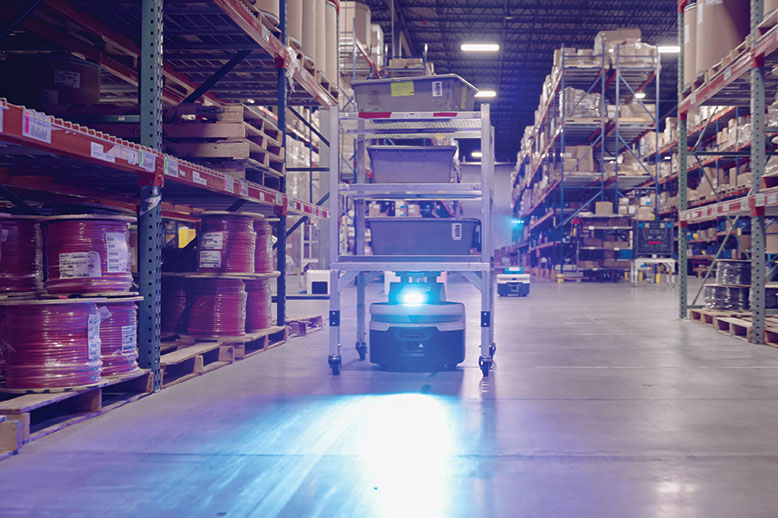Gaining throughput and space with mobile robots
A distributor of electrical components improves throughput with autonomous mobile robots by 25% while reclaiming space and freeing workers from select manual tasks.
Growth is a good thing for distributors, though it can strain the limits of existing distribution center automation and supporting manual processes.
This was the case for Waytek, a distributor of automotive electrical components. The company found itself facing growing pains in its fulfillment center systems before implementing a solution based on the flexibility of autonomous mobile robots (AMRs).
The company, headquartered in Chanhassen, Minn., and founded in 1970, is a family-owned distributor of electrical components to manufacturers and upfitters specializing in wire harnesses and mobile equipment. With a mission to provide an exceptional customer experience, Waytek is committed to making it easy for its customers to source electrical parts.
In 2007, Waytek had moved into its present 100,000-square-foot distribution facility to scale their operations and installed a sortation conveyor system to handle their expected volumes at that time. This conveyor system helped them sort orders up to the capacity of 800 orders per day for 13 years.
With a rise in component demand across the manufacturing sector combined with a tight labor market, Waytek found itself in the midst of challenging times by 2020. Order volumes quickly grew as a result of e-commerce growth and orders from existing customers, but existing warehouse automation technology, which included two separate horizontal carousel systems for storage and order picking, and the conveyor system, was about to reach its limits.
The conveyor sortation system was designed to sort 800 orders per day. It featured a 200-foot sortation loop that could hold 100 order totes at a time—the limiting factor holding that system to 800 orders per day. Increasing capacity would have meant a major redesign of the existing conveyor, interrupting operations.
Waytek wanted to keep its carousels and decided to look into put walls to sort orders and use AMRs as an alternative to conveyor to transport orders. That led the company to explore an AMR solution (Zebra Technologies) that could replace the conveyor and automate other tasks, like replenishing the carousels. Now the Cloud-based Fetch AMR solution from Zebra is used in place of the conveyor, as well as to replace the manual process of having associates bring goods from receiving to the carousels for replenishment. The AMRs also replaced a manual process for removal of dunnage and recycling.
“The AMRs drop off the inbound goods at the carousels, and order totes from the carousels go the put walls for packing on the AMRs,” says Mike Larson, COO and co-owner of Waytek. “They are able to multi-task while saving us floor space.”
Waytek’s AMR fleet was fully installed and operational in three days and consists of three Fetch CartConnect100 AMRs. The AMRs can position themselves under rolling mobile carts with shelves called FetchCarts to transport totes or materials.
Currently 32 carts are in the system, a handful of them used to automate the transport of dunnage and recycling, though most are used to transport order totes to the put wall or to automatically move goods from receiving to drop off to the carousels.
The CartConnect AMRs are set on a schedule to pick up the loaded order carts every 20 minutes and then deliver the payload to the put wall, and then return an empty cart back to the carousel.
With just three robots, the AMR solution is capable of processing up to 25% more orders per day versus the previous fixed automation, and the throughput level could be scaled up higher in the future by adding more robots.
Another benefit is that removal of the old system reclaimed 13% of the fulfillment center’s floor space. Other benefits of conveyor removal included ease of access for employees (they no longer needed to walk around long stretches of conveyor) and the reduction of ambient noise.
For associates in receiving who previously replenished the carousels with hand carts, or other workers who transported dunnage, the AMRs also eliminate some manual transport tasks. Using the FetchCore software that manages the AMR fleet and assignments, Waytek employees can operate the robots with tablets or mobile phones.
Overall, the solution is hitting its objectives, offers a future means to scale up throughput by adding bots, and has proven easy to deploy and operate, Larson explains.
“Among all our technological implementations until now, Fetch was the easiest to deploy and it took us only three days to become operational with their AMRs,” says Larson. “These AMRs are very easy to work with and rarely have any downtime. The Fetch team also consistently maintains and updates the robots on off-work hours, so we don’t have to worry about downtime.”













